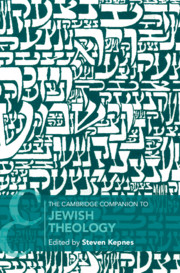Book contents
- The Cambridge Companion to JEWISH THEOLOGY
- cambridge companions to religion
- the cambridge companion to JEWISH THEOLOGY
- Copyright page
- Contents
- Notes on Contributors
- Acknowledgements
- 1 Introduction
- 2 What is Jewish Theology?
- Part I Biblical-Rabbinic
- Part II Medieval
- 6 Maimonides’ Theology
- 7 Law and Order: The Birth of a Nation and the Creation of the World
- 8 The Mystical Theology of Kabbalah: From God to Godhead
- Part III Modern
- Part IV Contemporary Issues
- Part V Analytic Philosophy and Theology
- Index
- Other Titles in the Series (continued from page ii)
- References
7 - Law and Order: The Birth of a Nation and the Creation of the World
from Part II - Medieval
Published online by Cambridge University Press: 03 December 2020
- The Cambridge Companion to JEWISH THEOLOGY
- cambridge companions to religion
- the cambridge companion to JEWISH THEOLOGY
- Copyright page
- Contents
- Notes on Contributors
- Acknowledgements
- 1 Introduction
- 2 What is Jewish Theology?
- Part I Biblical-Rabbinic
- Part II Medieval
- 6 Maimonides’ Theology
- 7 Law and Order: The Birth of a Nation and the Creation of the World
- 8 The Mystical Theology of Kabbalah: From God to Godhead
- Part III Modern
- Part IV Contemporary Issues
- Part V Analytic Philosophy and Theology
- Index
- Other Titles in the Series (continued from page ii)
- References
Summary
Every judge who judges with complete fairness even for a single hour, the Writ gives him credit as though he had become a partner to the Holy One, blessed be He, in the creation.(BT Shabbat 10a)
In acting and judging with fairness—in applying the law in an impartial and equitable way—a judge models himself on divine creation. In this chapter, I interpret this rabbinic dictum along Maimonidean lines, drawing in part on some of Maimonides’ own views on creation and Mosaic prophecy. In the second part of the Guide Maimonides draws close connections between the two topics, and I help myself to that in presenting my own discussion of the aforementioned rabbinic dictum. The chapter proceeds in three sections, over the course of which I am concerned with teasing out the juridical analogy in a variety of ways: morphologically/structurally, psychologically, and finally teleologically.
- Type
- Chapter
- Information
- The Cambridge Companion to Jewish Theology , pp. 132 - 148Publisher: Cambridge University PressPrint publication year: 2020



